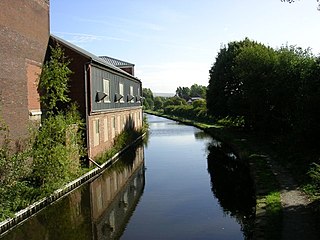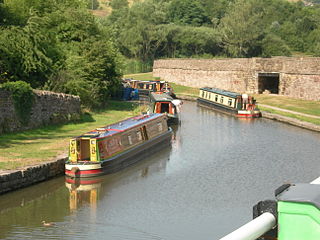Bibliography
- Cumberlidge, Jane (2009). Inland Waterways of Great Britain (8th Ed.). Imray Laurie Norie and Wilson. ISBN 978-1-84623-010-3.
Related Research Articles

A towpath is a road or trail on the bank of a river, canal, or other inland waterway. The purpose of a towpath is to allow a land vehicle, beasts of burden, or a team of human pullers to tow a boat, often a barge. This mode of transport was common where sailing was impractical due to tunnels and bridges, unfavourable winds, or the narrowness of the channel.

British Waterways, often shortened to BW, was a statutory corporation wholly owned by the government of the United Kingdom. It served as the navigation authority for the majority of canals and a number of rivers and docks in England, Scotland and Wales.

The Bridgwater and Taunton Canal is a canal in the south-west of England between Bridgwater and Taunton, opened in 1827 and linking the River Tone to the River Parrett. There were a number of abortive schemes to link the Bristol Channel to the English Channel by waterway in the 18th and early 19th centuries. These schemes followed the approximate route eventually taken by the Bridgwater and Taunton Canal, but the canal was instead built as part of a plan to link Bristol to Taunton by waterway.

The Grantham Canal ran for 33 miles (53 km) from Grantham through 18 locks to West Bridgford, where it joins the River Trent. It was built primarily for the transportation of coal to Grantham. It opened in 1797 and its profitability steadily increased until 1841. It was then sold to a railway company, declined, and was finally closed in 1936. It was used as a water supply for agriculture, and so most of it remained in water after closure, although bridges were lowered. Since the 1970s, the Grantham Canal Society have been working to restore parts of it. Two stretches are now navigable to small vessels. A new route will be required where the canal joins the Trent, as road building has severed the original one.

The Ashton Canal is a canal in Greater Manchester, England.
The IWA National Festival & Boat Show run by the Inland Waterways Association is one of the key annual events on the United Kingdom's inland waterways. Generally referred to as the "National" it serves several functions:

The Inland Waterways Association (IWA) is a registered charity in the United Kingdom and was formed in 1946 to campaign for the conservation, use, maintenance, restoration and sensitive development of British Canals and river navigations.

Dudley Tunnel is a canal tunnel on the Dudley Canal Line No 1, England. At about 3,172 yards (2,900.5 m) long, it is now the second longest canal tunnel on the UK canal network today.. However, since the Dudley Tunnel is not continuous this status is sometimes questioned:.

The Bugsworth Basin Heritage Trust (BBHT), formerly known as the Inland Waterways Protection Society (IWPS), is a British organisation founded in 1958 to work for the restoration of the canal system. Its members carried out surveys of canals and produced reports in support of their retention when much of the canal network was under threat. Following official support for use of the canals for leisure activities in 1967, the Society have concentrated their efforts on the restoration and operation of Bugsworth Basin, located at the southern end of the Peak Forest Canal, which was one of the first canals that they surveyed in 1958.

The Sheffield & Tinsley Canal is a canal in the City of Sheffield, England. It runs 3.9 miles (6.3 km) from Tinsley, where it leaves the River Don, to the Sheffield Canal Basin in the city centre, passing through 11 locks. The maximum craft length that can navigate this lock system is 61 feet 6 inches (18.75 m) with a beam of 15 feet 6 inches (4.72 m).

Marple Junction is the name of the canal junction where the Macclesfield Canal terminates and meets the Peak Forest Canal at Marple, Greater Manchester, England.
The Shropshire Union Canal Society is an organisation formed to promote interest in and enhance the Shropshire Union Canal system, in England and Wales.

The Horseboating Society is a national society, with the primary aim being the preservation and promotion of Horseboating on the canals of Great Britain. The Society was founded on 19 January 2001 at the Ellesmere Port Boat Museum, and it is the only organisation in the UK solely dedicated to horseboating.
The Association of Waterways Cruising clubs is a waterway society and umbrella organisation in England, UK. It was founded in the early 1960s by the St Pancras, Dunstable, Uxbridge and Lee and Stort boat clubs as an inter-club scheme for an emergency service for boaters, and for safe overnight moorings.

The East Anglian Waterways Association is a waterway society and an umbrella organisation in East Anglia, England, UK.

The Foxton Inclined Plane Trust is a waterway society and a registered charity on the Grand Union Canal at Foxton, Leicestershire, England, UK. It was founded in 1980 to promote the restoration of the Victorian boat lift or inclined plane, a unique and famous piece of canal history.
The Ribble Link Trust is a waterway society, campaigners, instigators of and involved in the Ribble Link, a navigable waterway that connects the Lancaster Canal to the Leeds and Liverpool Canal in Lancashire, England, via the River Ribble.

The River Weaver Navigation Society is a waterway society concerned with the River Weaver, from Winsford to its confluence with the Manchester Ship Canal.

The Canal & River Trust, branded as Glandŵr Cymru in Wales, holds the guardianship of 2,000 miles of canals and rivers, together with reservoirs and a wide range of heritage buildings and structures, in England and Wales. Launched on 12 July 2012, the Trust took over the responsibilities of the state-owned British Waterways.
References
- ↑ "Past, Present and Future". Towpath Action Group. Retrieved 3 February 2012.
- ↑ Cumberlidge 2009 , p. 11
- ↑ "Memorandum by The Towpath Action Group (WTC 57)". parliament.uk. Retrieved 3 February 2012.